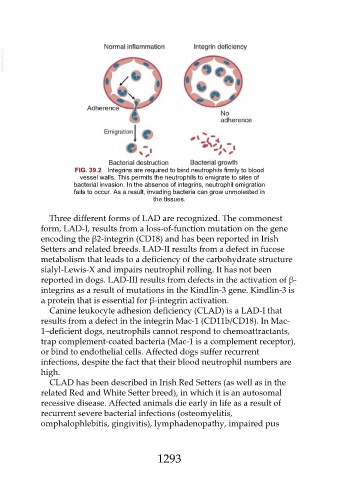Page 1293 - Veterinary Immunology, 10th Edition
P. 1293
VetBooks.ir
FIG. 39.2 Integrins are required to bind neutrophils firmly to blood
vessel walls. This permits the neutrophils to emigrate to sites of
bacterial invasion. In the absence of integrins, neutrophil emigration
fails to occur. As a result, invading bacteria can grow unmolested in
the tissues.
Three different forms of LAD are recognized. The commonest
form, LAD-I, results from a loss-of-function mutation on the gene
encoding the β2-integrin (CD18) and has been reported in Irish
Setters and related breeds. LAD-II results from a defect in fucose
metabolism that leads to a deficiency of the carbohydrate structure
sialyl-Lewis-X and impairs neutrophil rolling. It has not been
reported in dogs. LAD-III results from defects in the activation of β-
integrins as a result of mutations in the Kindlin-3 gene. Kindlin-3 is
a protein that is essential for β-integrin activation.
Canine leukocyte adhesion deficiency (CLAD) is a LAD-I that
results from a defect in the integrin Mac-1 (CD11b/CD18). In Mac-
1–deficient dogs, neutrophils cannot respond to chemoattractants,
trap complement-coated bacteria (Mac-1 is a complement receptor),
or bind to endothelial cells. Affected dogs suffer recurrent
infections, despite the fact that their blood neutrophil numbers are
high.
CLAD has been described in Irish Red Setters (as well as in the
related Red and White Setter breed), in which it is an autosomal
recessive disease. Affected animals die early in life as a result of
recurrent severe bacterial infections (osteomyelitis,
omphalophlebitis, gingivitis), lymphadenopathy, impaired pus
1293

